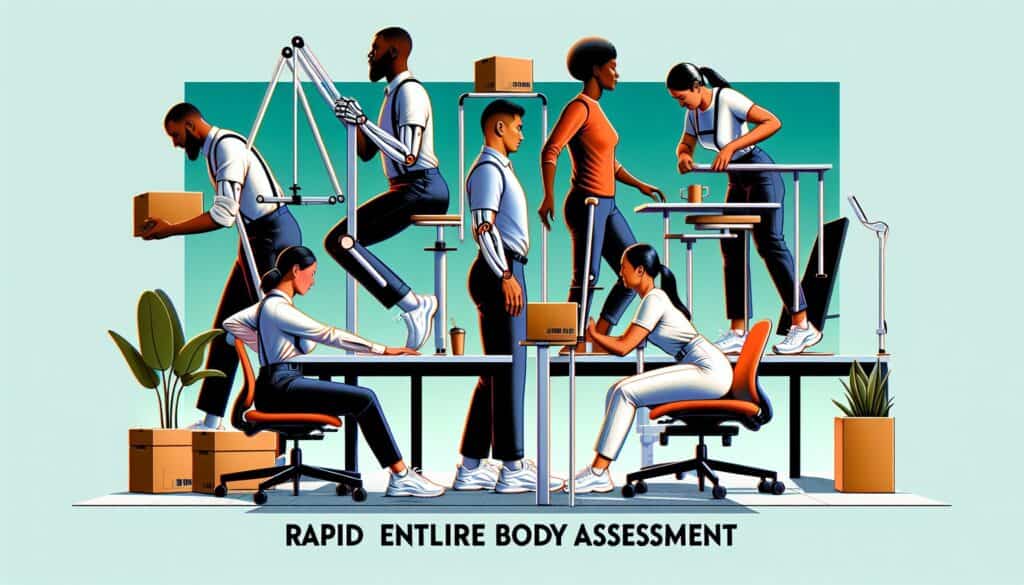Un outil d'observation utilisé pour évaluer les risques posturaux de troubles musculo-squelettiques du corps entier liés au travail.
- Méthodologies : Ergonomie
REBA (Rapid Entire Body Assessment)

REBA (Rapid Entire Body Assessment)
- Amélioration continue, Ergonomie, Facteurs humains, Conception centrée sur l'humain, Production allégée, Amélioration des processus, Gestion de la qualité, Gestion des risques, Safety
Objectif :
Comment il est utilisé :
- Il évalue les postures du cou, du tronc, des jambes et des bras, ainsi que le couplage, la charge/force et l'activité. Des scores sont générés pour indiquer le niveau de risque de TMS et l'urgence d'une intervention.
Avantages
- Fournit une évaluation holistique des risques posturaux pour l'ensemble du corps ; relativement rapide à utiliser ; aide à hiérarchiser les emplois en vue d'améliorations ergonomiques.
Inconvénients
- Peut être subjectif ; nécessite une formation pour une notation cohérente ; principalement un outil de dépistage, peut nécessiter une analyse plus approfondie pour la conception d'une intervention détaillée.
Catégories :
- Ergonomie
Idéal pour :
- Évaluation des risques posturaux pour les troubles musculo-squelettiques affectant l'ensemble du corps.
La méthodologie REBA (Rapid Entire Body Assessment) trouve des applications dans divers secteurs, notamment la fabrication, la construction, les soins de santé et la logistique, où les employés sont fréquemment engagés dans des tâches nécessitant des mouvements répétitifs ou des postures contraignantes soutenues. Cette évaluation est particulièrement utile lors de la phase de conception des espaces de travail ou des flux de travail, notamment lorsqu'il s'agit de prendre en compte les exigences physiques des travailleurs, ce qui permet aux équipes d'évaluer et de redéfinir les spécificités des tâches susceptibles d'entraîner des blessures. Dans les contextes d'ingénierie et de conception de produits, les participants sont souvent des ergonomes, des professionnels de la santé et de la sécurité et des chefs d'équipe chargés d'optimiser les flux de travail. La méthodologie facilite l'évaluation objective en générant des scores numériques qui catégorisent le niveau de risque de troubles musculo-squelettiques (TMS) associé à des postures et à des tâches spécifiques, ce qui permet de hiérarchiser les emplois en vue d'interventions ergonomiques. La rapidité d'application du REBA encourage son utilisation dans les évaluations de routine, ce qui permet aux entreprises de suivre régulièrement les changements de posture et de conditions de travail, dans le but ultime de réduire les taux d'accidents et d'améliorer le bien-être des travailleurs. Des sessions de formation pourraient être organisées pour éduquer les employés à tous les niveaux sur le REBA, afin de les sensibiliser aux principes ergonomiques qui favorisent un environnement de travail plus sûr. L'application régulière de ces évaluations permet non seulement de respecter les directives en matière de santé au travail, mais aussi d'améliorer la productivité en réduisant la fatigue et l'absentéisme associés aux TMS.
Principales étapes de cette méthodologie
- Observez la posture du travailleur pendant la tâche.
- Évaluer la posture du cou, du tronc, des jambes et des bras à l'aide de critères de notation prédéfinis.
- Évaluer le niveau de couplage entre les parties du corps pendant la tâche.
- Évaluer toute charge ou force exercée sur le corps.
- Tenez compte de l'activité spécifique exercée et de ses exigences.
- Calculer la note totale sur la base des notes individuelles.
- Déterminer le niveau de risque de troubles musculo-squelettiques en fonction du score.
- Prioriser les besoins d'intervention en fonction des résultats de l'évaluation.
Conseils de pro
- Intégrer une approche d'évaluation dynamique en combinant les résultats de la REBA avec une étude temps-mouvement afin d'améliorer la compréhension des tâches répétitives et de leur impact sur la posture du travailleur.
- Utiliser des outils numériques, tels que des logiciels de capture de mouvement, pour compléter l'analyse REBA afin d'identifier plus précisément les risques posturaux et les applications de force.
- Mettre régulièrement à jour les critères de notation du REBA sur la base des recherches émergentes et des meilleures pratiques afin de garantir la pertinence et l'exactitude de l'évaluation des environnements de travail modernes.
Lire et comparer plusieurs méthodologies, nous recommandons le
> Référentiel méthodologique étendu <
ainsi que plus de 400 autres méthodologies.
Vos commentaires sur cette méthodologie ou des informations supplémentaires sont les bienvenus sur le site web de la Commission européenne. section des commentaires ci-dessous ↓ , ainsi que toute idée ou lien en rapport avec l'ingénierie.
Contexte historique
1986
(si la date est inconnue ou n'est pas pertinente, par exemple "mécanique des fluides", une estimation arrondie de son émergence notable est fournie)

Articles Similaires
Programme directeur de production (PDP)
Personnalisation de masse
Entonnoir marketing
Audit marketing
Indice MAPO (Mouvement et assistance des patients hospitalisés)
Planification des ressources de fabrication (MRP II)